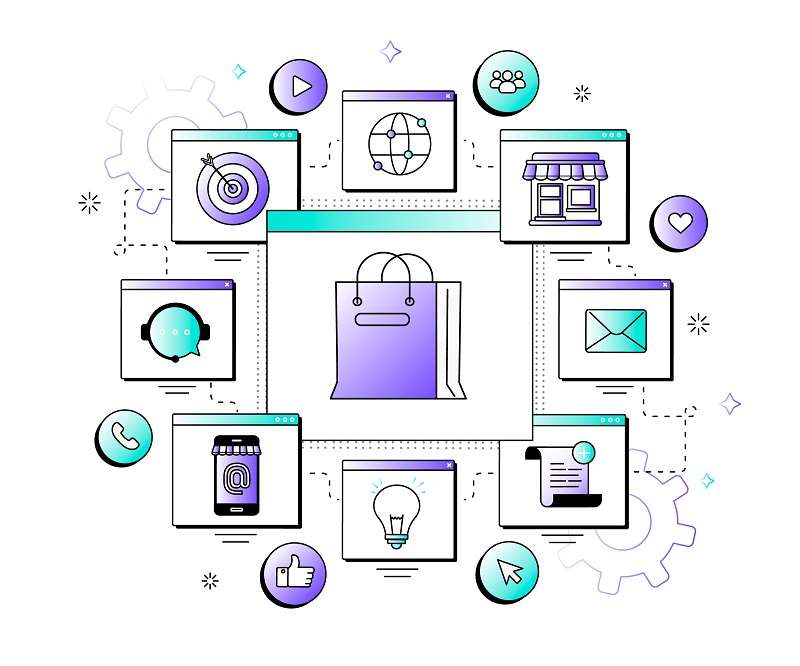Omnichannel Marketing for 2024: Strategies, Tools, and Best Practices
Omnichannel marketing means making shopping super smooth for customers across many places. Instead of juggling lots of different channels, it's like all the channels are working together and saying the same thing. Customers can pick how they want to shop, and everything is friendly and personalized. Marketers use data to make it special for each person. It's like making sure your brand shines bright no matter where people find you.
Omnichannel marketing is all about giving customers a smooth experience, whether they're shopping online, in a store, or on their phone. It's like making sure everything fits together nicely. Marketers use this strategy to make sure everything about their brand is the same, so customers always know what to expect. The goal is to keep things consistent, no matter how customers connect with the brand. It's about giving customers a great experience, no matter where they find you.
Omnichannel Marketing for 2024: Trends, Tools, Strategies and Best Practices
Unlocking Seamless Consistency: The Power of Omnichannel Marketing
Omnichannel marketing is a holistic approach that allows businesses to provide a consistent experience for customers across multiple channels. This means that no matter where customers shop - online, in-store, or on social media - they get the same great experience. To make this happen, everyone in the company has to work together and use the same message.
This kind of marketing also means that when customers switch between different ways of shopping, like using their phone or going to a store, everything works smoothly. It's all about giving customers a seamless experience, and everyone in the company needs to understand and use the same brand message to make it work.
Omnichannel Marketing vs Multichannel Marketing
Omnichannel marketing and multichannel marketing are both strategies used by businesses to reach and engage with their customers across various channels. However, there are some key differences between the two approaches.
Multichannel marketing refers to using multiple channels to interact with customers, such as email, social media, websites, and physical stores. The focus is on ensuring a presence across different channels and giving customers options to choose how they want to engage with the business. While this approach is effective in reaching a wide audience, the challenge lies in maintaining consistency and providing a seamless experience across all channels.
In contrast, omnichannel marketing is all about making things work together. It aims to give customers a smooth and consistent experience, whether they're online or in a store. The idea is to make the whole journey seamless, so customers can switch between different ways of shopping without any problems. This takes knowing a lot about what customers like and using technology to bring everything together.
In essence, multichannel marketing is about having a presence on multiple channels, while omnichannel marketing is about creating a cohesive and integrated experience across those channels. Omnichannel marketing recognizes the importance of delivering a consistent message, personalized interactions, and smooth transitions between channels to enhance the customer experience and build stronger relationships.
Ultimately, the choice between omnichannel and multichannel marketing depends on the specific goals and resources of a business. However, with the increasing expectations of customers for a seamless and personalized experience, many businesses are shifting towards adopting an omnichannel approach to stay competitive in today's market.
How to Build an Omni-Channel Marketing Campaign?

Building an omnichannel marketing campaign requires careful planning, organization, and execution. Here are some steps to help you get started:
1. Understand your audience: Begin by gaining a deep understanding of your target audience. Conduct market research, analyze customer data, and identify their preferences, behaviors, and pain points. This will help you tailor your campaign to resonate with your audience across different channels.
2. Set clear goals: Determine the objectives of your campaign. Are you aiming to increase brand awareness, drive sales, or enhance customer loyalty? Set specific, measurable goals to guide your campaign strategy.
3. Develop a cohesive brand message: Ensure that your brand message is consistent across all channels. This includes your tone of voice, visual elements, and key brand values. Craft a compelling and unified message that will resonate with your audience and reinforce your brand identity.
4. Choose the right channels: Identify the channels that your target audience uses and prefers. This could include social media platforms, email marketing, mobile apps, physical stores, or any other relevant channels. Consider how these channels can be integrated to provide a seamless experience for your customers.
5. Integrate data and systems: Implement systems that allow for the seamless integration of customer data across channels. This will enable you to track customer interactions, preferences, and behaviors, and provide personalized experiences. Utilize customer relationship management (CRM) software or other tools to centralize and analyze data.
6. Provide a consistent user experience: Ensure that the user experience is consistent across all channels. Design your website, mobile app, social media profiles, and physical stores in a way that reflects your brand and provides a seamless transition for customers. Make sure that information, promotions, and offers are consistent and readily available across all touchpoints.
7. Personalize communication: Leverage the data you have collected to personalize communication with your customers. Tailor messages, offers, and recommendations based on their preferences and behaviors. This will enhance customer engagement and increase the effectiveness of your campaign.
8. Monitor and optimize: Continuously monitor the performance of your campaign across channels. Track key metrics, such as conversion rates, engagement levels, and customer feedback. Use this data to optimize your campaign, make informed decisions, and improve the customer experience over time.
Remember, building an omnichannel marketing campaign is an ongoing process. It requires consistent monitoring, analysis, and adaptation to meet the evolving needs and preferences of your audience. By providing a seamless and personalized experience, you can build stronger customer relationships and drive better results for your business.
What are Omnichannel Marketing Strategies?
Creating an omnichannel marketing strategy involves a comprehensive approach that integrates various channels to deliver a seamless and personalized customer experience. Here's a step-by-step guide to help you develop an effective omnichannel marketing strategy:
1. Define your goals: Start by clearly identifying your marketing objectives. Whether it's increasing sales, improving brand awareness, or enhancing customer loyalty, having specific goals will guide your strategy.
2. Understand your target audience: Gain a deep understanding of your target audience's preferences, behaviors, and pain points. Conduct market research, analyze customer data, and use segmentation to tailor your messages to different customer segments.
3. Map the customer journey: Identify the touchpoints and interactions customers have with your brand across various channels. This will help you understand the customer journey and identify opportunities to enhance the experience and drive conversions.
4. Choose the right channels: Determine which channels are most relevant to your target audience. Consider both online and offline channels, such as websites, social media, email marketing, mobile apps, physical stores, and call centers. Select channels that align with your audience's preferences and integrate them seamlessly.
5. Integrate data and systems: Integrate your customer data across channels to create a centralized view of each customer. This will allow you to provide a consistent experience and personalize interactions based on customer preferences and behaviors. Implement customer relationship management (CRM) software or other tools to manage and analyze data effectively.
6. Develop a cohesive brand message: Ensure that your brand message is consistent across all channels. Create a unified brand voice, tone, and visual identity to reinforce your brand image and values. Craft compelling and relevant content that resonates with your target audience and aligns with their journey.
7. Personalize customer experiences: Utilize the data you have collected to personalize interactions with your customers. Tailor messages, offers, and recommendations based on their preferences, purchase history, and behaviors. Provide relevant content and recommendations across channels to enhance the customer experience.
8. Provide a seamless experience: Focus on creating a seamless and consistent user experience across all touchpoints. Ensure that customers can easily transition between channels without any disruptions. Optimize your website and mobile app for a smooth browsing and purchasing experience, and align the design and messaging across all channels.
9. Measure and optimize: Continuously monitor the performance of your omnichannel marketing efforts. Track key metrics such as conversion rates, engagement levels, customer satisfaction, and ROI. Use this data to optimize your strategy, make data-driven decisions, and improve the customer experience over time.
10. Adapt and evolve: Stay informed about emerging trends and technologies to adapt your strategy accordingly. Continuously test and experiment with new channels, messaging, and tactics to stay ahead of the competition and meet the evolving needs of your audience.
Remember, building an effective omnichannel marketing strategy requires ongoing monitoring, analysis, and adaptation. By providing a seamless and personalized experience, you can build stronger customer relationships, drive better results, and differentiate your brand in the competitive market.
Real World Example of Omnichannel Marketing Strategy

Sure! Here's a simple example of an omnichannel marketing strategy:
Let's say there is a clothing retailer called "Fashion Haven". They want to create a seamless and personalized shopping experience for their customers across various channels. Here's how they implement an omnichannel marketing strategy:
1. Online Presence: Fashion Haven has a user-friendly website where customers can browse their collections, read product descriptions, and make purchases. They also have a mobile app for customers who prefer shopping on their smartphones.
2. Social Media Marketing: Fashion Haven maintains active profiles on popular social media platforms like Facebook, Instagram, and Twitter. They regularly post engaging content, share updates about new arrivals, and run targeted ad campaigns to reach their target audience.
3. Email Marketing: Fashion Haven collects email addresses from customers and sends personalized emails with exclusive offers, discounts, and personalized product recommendations based on their browsing and purchase history.
4. Physical Store Experience: Fashion Haven ensures consistency across their physical stores by implementing technologies like RFID tags and mobile payment options. They also offer in-store pickup for online orders, making it convenient for customers.
5. Customer Loyalty Program: Fashion Haven has a loyalty program that rewards customers for their purchases, referrals, and social media engagement. These rewards can be redeemed both online and in-store, creating a seamless experience.
6. Customer Support: Fashion Haven provides 24/7 customer support through various channels like live chat, phone, and social media. They ensure prompt and helpful responses to any queries or concerns.
By implementing this omnichannel marketing strategy, Fashion Haven creates a cohesive and personalized shopping experience for their customers, regardless of the channel they choose to engage with. This approach not only enhances customer satisfaction but also increases brand loyalty and drives sales.
Benefits of Omnichannel Marketing
The Benefits of omnichannel marketing are vast and can benefit businesses in several ways. Here are some key opportunities that omnichannel marketing presents:
1. Enhanced Customer Experience: Omnichannel marketing allows businesses to provide a seamless and consistent experience to customers across multiple channels. This means customers can engage with a brand through various touchpoints, such as websites, social media, mobile apps, physical stores, and more. By integrating these channels, businesses can deliver a personalized and convenient experience, leading to higher customer satisfaction and loyalty.
2. Increased Customer Engagement: Omnichannel marketing enables businesses to engage customers across diverse platforms, capturing their attention more effectively. By leveraging multiple channels, brands can connect with customers at every stage of their buyer journey, delivering tailored messaging that resonates. This approach not only boosts engagement but also strengthens brand recall and fosters more meaningful customer interactions, creating a seamless experience that drives loyalty and conversion.
3. Data-Driven Insights: By integrating multiple channels, businesses can gather valuable data on customer behavior, preferences, and purchase patterns. This data can be analyzed to gain insights into customer needs, preferences, and trends, enabling businesses to make more informed marketing decisions. This information can be used to create targeted campaigns, personalized offers, and improve overall business strategies.
4. Improved Conversion Rates: With omnichannel marketing, businesses can guide customers seamlessly through their buying journey, making it easier for them to make a purchase. By providing consistent messaging, personalized recommendations, and a frictionless experience, businesses can increase conversion rates and drive sales.
5. Competitive Advantage: Implementing an effective omnichannel marketing strategy can give businesses a competitive edge. By delivering a superior customer experience compared to competitors, businesses can differentiate themselves and attract more customers. Additionally, businesses that successfully integrate online and offline channels can tap into a wider customer base and reach more potential buyers.
6. Customer Retention and Loyalty: Omnichannel marketing allows businesses to build stronger relationships with customers. By providing a consistent experience across channels and offering personalized incentives, businesses can increase customer loyalty and retention rates. Repeat customers are more likely to spend more, refer others, and become brand advocates.
Overall, embracing the opportunities of omnichannel marketing can help businesses improve customer experience, increase engagement, drive sales, and gain a competitive advantage in today's highly connected and digital world.
Omnichannel Marketing Tools
Certainly! Here is an expanded list of omnichannel marketing tools that includes the ones you mentioned:
1. Customers.ai: A customer analytics platform that helps you understand and engage with your customers across various channels.
2. MailChimp: A popular email marketing platform that also supports social media advertising and marketing automation.
3. AgoraPulse: A social media management tool that allows you to schedule and monitor posts, engage with your audience, and analyze performance.
4. MeetEdgar: A social media scheduling tool that automatically reposts evergreen content to maximize its reach.
5. BuzzSumo: A content discovery and social media monitoring tool that helps you identify trending topics and influencers.
6. AddThis: A social sharing and engagement platform that enables you to add share buttons and personalized recommendations to your website.
7. Phantombuster: A web scraping tool that allows you to extract data from various websites and automate marketing workflows.
8. SEMrush: An all-in-one digital marketing platform that provides keyword research, competitive analysis, and SEO tools.
9. SE Ranking: An SEO software that helps you track keyword rankings, conduct site audits, and analyze competitor data.
10. AdEspresso: A social media advertising platform that streamlines the creation, testing, and optimization of ad campaigns.
11. Zapier: A workflow automation tool that connects various apps and platforms, allowing you to automate repetitive tasks.
12. Autopilot: A marketing automation platform that helps you create personalized customer journeys across multiple channels.
13. Clearbit: A data enrichment platform that provides valuable insights about your customers, enabling better targeting and personalization.
Remember, it's important to evaluate each tool based on your specific needs and requirements to ensure they align with your marketing goals and budget.
Omnichannel Marketing Statistics
Omnichannel marketing statistics highlight the benefits of this approach:
1. Increased customer retention: Firms with omnichannel strategies achieve 91% higher year-over-year customer retention rates compared to those without. This creates stronger customer relationships and boosts loyalty.
2. Strong omnichannel engagement: Businesses with robust omnichannel strategies retain 89% of customers, compared to an average of 33% for weak strategies. Seamless integration across channels enhances satisfaction and drives higher retention rates.
3. Increased customer spend: According to a study by IDC, customers who engage with a brand across multiple channels have a 30% higher lifetime value compared to those who only engage through a single channel. This demonstrates the power of omnichannel marketing in driving higher customer spend and overall revenue.
4. Improved conversion rates: Research from Google indicates that companies with strong omnichannel strategies experience a 32% increase in conversion rates compared to those with weak or no omnichannel presence. By providing a seamless and integrated customer journey, businesses can enhance the likelihood of conversion and drive better sales performance.
These statistics emphasize the advantages of implementing an omnichannel marketing strategy. By providing a consistent and personalized experience, businesses can improve customer loyalty and drive sustainable growth.
How to be Successful with Omnichannel Marketing?
To be successful with omnichannel marketing, consider the following strategies:
1. Consistent Branding: Ensure that your brand message, tone, and visual identity are consistent across all channels. This helps customers recognize and connect with your brand, regardless of where they encounter it.
2. Customer-Centric Approach: Understand your target audience and their preferences. Tailor your messaging and content to meet their needs and expectations on each channel. Personalization is key to building strong customer relationships.
3. Seamless User Experience: Provide a seamless and effortless experience for customers as they transition between different channels. Ensure that information, promotions, and offers are consistent across platforms, making it easy for customers to engage with your brand.
4. Data-Driven Decision Making: Leverage data analytics to gain insights into customer behavior, preferences, and buying patterns. Use this data to optimize your marketing efforts, identify trends, and make informed decisions about which channels are most effective for your target audience.
5. Integration and Automation: Integrate your marketing channels and technologies to create a unified experience. Automation tools can help streamline processes and ensure consistent messaging across all touchpoints, saving time and improving efficiency.
6. Continuous Evaluation and Optimization: Regularly assess the performance of your omnichannel marketing efforts. Monitor key metrics such as conversion rates, engagement levels, and customer feedback. Use this information to refine your strategies and improve results over time.
Remember, success with omnichannel marketing requires a holistic approach that puts the customer at the center. By delivering a seamless and personalized experience across all channels, you can build brand loyalty, increase customer engagement, and drive business growth.
Industries Applying Omnichannel Tactics

Sure! Here's a shorter version with a paragraph for each industry:
1. Retail: Retailers integrate physical stores, e-commerce platforms, mobile apps, and social media to provide a seamless shopping experience.
2. E-commerce: Online retailers combine their website, mobile apps, email marketing, social media, and customer service channels to deliver personalized experiences and targeted promotions.
3. Travel and Hospitality: Travel companies integrate websites, mobile apps, call centers, social media, and physical locations to provide a seamless booking experience.
4. Banking and Financial Services: Banks integrate online platforms, mobile apps, ATMs, call centers, and physical branches to offer customers a seamless banking experience.
5. Telecommunications: Telecommunication companies integrate websites, mobile apps, call centers, social media, and physical stores to provide consistent and personalized support.
6. Healthcare: Healthcare providers integrate websites, mobile apps, telehealth platforms, patient portals, and physical locations to improve patient experience and engagement.
These industries are successfully implementing omnichannel strategies to enhance marketing and customer experience.
Omnichannel Marketing Best Practices
Sure! Here are 8 Omnichannel Marketing Best Practices to help you create a successful marketing strategy:
1. Consistent Branding: Maintain a consistent brand image across all channels, including websites, social media, emails, and physical stores. This helps build recognition and trust among your target audience.
2. Customer-Centric Approach: Focus on delivering a seamless and personalized experience to your customers. Collect data from various touchpoints to understand their preferences and tailor your marketing messages accordingly.
3. Cross-Channel Integration: Integrate your marketing channels to ensure a cohesive experience for your customers. For example, use social media to promote your website and vice versa. This helps create a holistic brand experience.
4. Data-Driven Decision Making: Leverage customer data to make informed marketing decisions. Analyze data from different channels to understand customer behavior, preferences, and engagement levels. This allows you to optimize your marketing efforts effectively.
5. Mobile Optimization: With the rise of mobile usage, it's essential to optimize your marketing channels for mobile devices. Ensure that your website, emails, and other digital assets are mobile-friendly to provide a seamless experience across devices.
6. Personalization: Tailor your marketing messages to individual customers based on their preferences and behavior. Use data to create personalized recommendations, offers, and content that resonate with your audience.
7. Seamless Customer Journey: Map out the customer journey across different channels and touchpoints. Ensure a smooth transition from one channel to another, allowing customers to pick up where they left off. This reduces friction and improves the overall experience.
8. Continuous Testing and Optimization: Regularly test different marketing strategies and channels to determine what works best for your business. Use analytics tools to measure the effectiveness of your campaigns and make necessary adjustments to improve results.
By implementing these best practices, you can create a cohesive and effective omnichannel marketing strategy that drives engagement, boosts customer loyalty, and ultimately increases conversions.
Conclusion
In conclusion, omnichannel marketing is no longer just a strategy-it's a necessity for brands looking to thrive in today’s competitive market. By creating a unified and seamless experience across all touchpoints, businesses can meet customers wherever they are, making their journeys smoother and more satisfying. This approach not only builds loyalty and trust but also drives higher engagement and conversions as customers feel valued and understood.
As technology and consumer expectations evolve, brands that embrace and continuously optimize their omnichannel strategy will lead the way, staying agile and connected to their audiences. For lasting success, it’s essential to view omnichannel marketing as an ongoing journey-one that adapts to shifts in the market and keeps the customer experience at its core.





